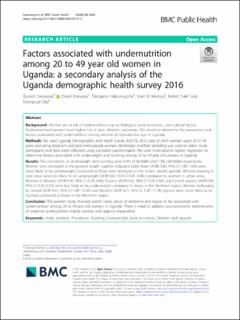| dc.contributor.author | Sserwanja, Quraish | |
| dc.contributor.author | Mukunya, David | |
| dc.contributor.author | Habumugisha, Theogene | |
| dc.contributor.author | Mutisya, Linet M | |
| dc.contributor.author | Tuke, Robert | |
| dc.contributor.author | Olal, Emmanuel | |
| dc.date.accessioned | 2021-07-16T06:54:25Z | |
| dc.date.available | 2021-07-16T06:54:25Z | |
| dc.date.created | 2020-11-24T15:35:45Z | |
| dc.date.issued | 2020-11-03 | |
| dc.identifier.issn | 1471-2458 | |
| dc.identifier.uri | https://hdl.handle.net/11250/2764588 | |
| dc.description.abstract | Background: Women are at risk of undernutrition due to biological, socio-economic, and cultural factors. Undernourished women have higher risk of poor obstetric outcomes. We aimed to determine the prevalence and factors associated with undernutrition among women of reproductive age in Uganda.
Methods: We used Uganda Demographic and Health Survey (UDHS) 2016 data of 4640 women aged 20 to 49 years excluding pregnant and post-menopausal women. Multistage stratified sampling was used to select study participants and data were collected using validated questionnaires. We used multivariable logistic regression to determine factors associated with underweight and stunting among 20 to 49 year old women in Uganda.
Results: The prevalence of underweight and stunting were 6.9% (318/4640) and 1.3% (58/4640) respectively. Women who belonged to the poorest wealth quintile (Adjusted Odds Ratio (AOR) 3.60, 95% CI 1.85–7.00) were more likely to be underweight compared to those who belonged to the richest wealth quintile. Women residing in rural areas were less likely to be underweight (AOR 0.63, 95%CI 0.41–0.96) compared to women in urban areas. Women in Western (AOR 0.30, 95% CI 0.20–0.44), Eastern (AOR 0.42, 95% CI 0.28–0.63) and Central regions (AOR 0.42, 95% CI 0.25–0.72) were less likely to be underweight compared to those in the Northern region. Women belonging to Central (AOR 4.37, 95% CI 1.44–13.20) and Western (AOR 4.77, 95% CI 1.28–17.78) regions were more likely to be stunted compared to those in the Northern region.
Conclusion: The present study showed wealth index, place of residence and region to be associated with undernutrition among 20 to 49 year old women in Uganda. There is need to address socio-economic determinants of maternal undernutrition mainly poverty and regional inequalities. | en_US |
| dc.language.iso | eng | en_US |
| dc.publisher | BioMed Central | en_US |
| dc.rights | Navngivelse 4.0 Internasjonal | * |
| dc.rights.uri | http://creativecommons.org/licenses/by/4.0/deed.no | * |
| dc.title | Factors associated with undernutrition among 20 to 49 year old women in Uganda: a secondary analysis of the Uganda demographic health survey 2016 | en_US |
| dc.type | Journal article | en_US |
| dc.type | Peer reviewed | en_US |
| dc.description.version | publishedVersion | en_US |
| dc.rights.holder | Copyright the authors | en_US |
| dc.source.articlenumber | 1644 | en_US |
| cristin.ispublished | true | |
| cristin.fulltext | original | |
| cristin.fulltext | original | |
| cristin.qualitycode | 1 | |
| dc.identifier.doi | 10.1186/s12889-020-09775-2 | |
| dc.identifier.cristin | 1851805 | |
| dc.source.journal | BMC Public Health | en_US |
| dc.identifier.citation | BMC Public Health. 2020, 20, 1644. | en_US |
| dc.source.volume | 20 | en_US |

